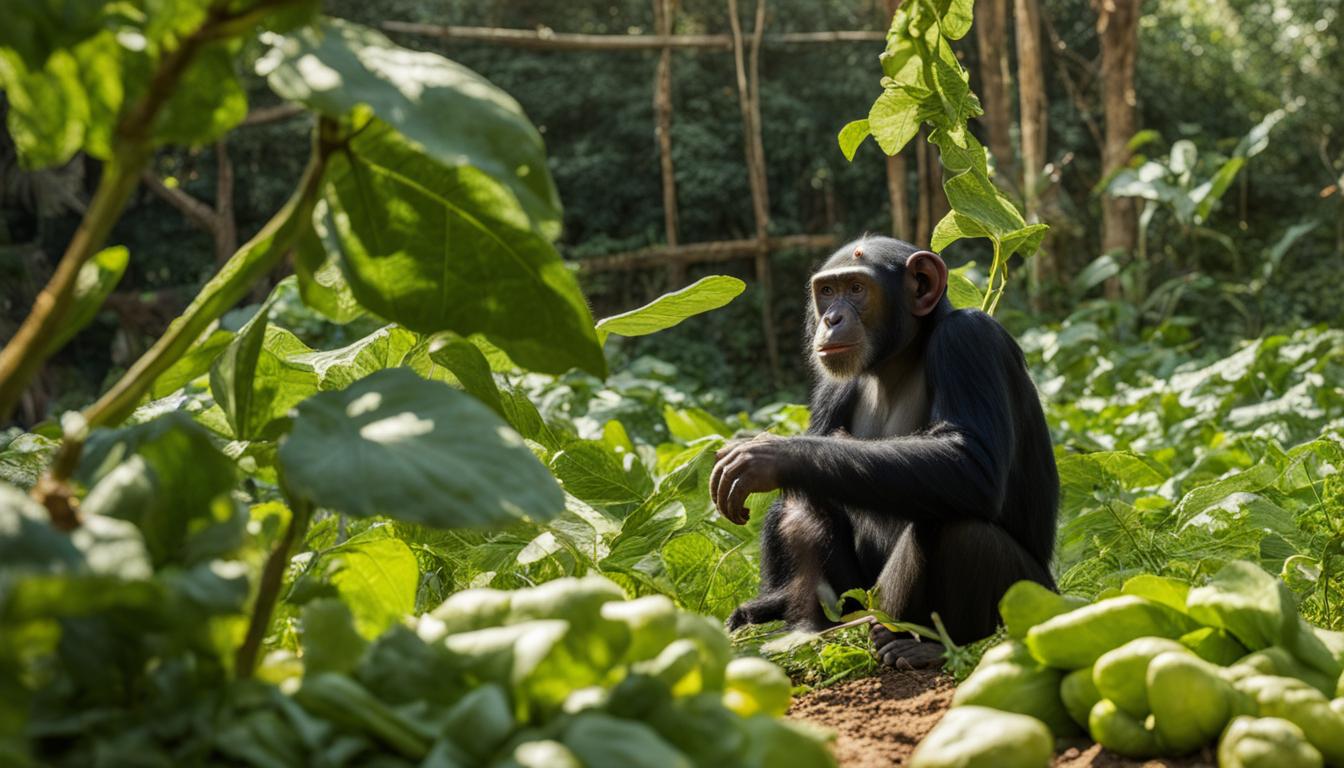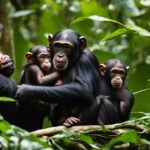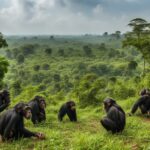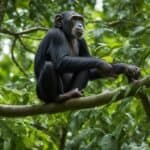Welcome! In this article, we delve into the intriguing connection between chimpanzees and agriculture, shedding light on their adaptability to changing landscapes and their vital role in wildlife conservation. Chimpanzees, with their behavioral plasticity, have the potential to respond flexibly to agricultural environments, making their survival paramount.
Chimpanzees, being selective feeders, have a preference for ripe fruits. However, they also exploit a variety of crops, including non-fruit crops, when they are accessible. By understanding the dynamic responses of these primates to agriculture, we gain essential insights into their adaptability and can inform effective conservation strategies.
Through this exploration, we aim to shed light on the fascinating foraging adaptations of chimpanzees in agricultural landscapes. They exhibit an omnivorous crop selection, focusing on fruits while also consuming non-fruit crops. These feeding behaviors, influenced by local traditions, contribute to the variations observed among chimpanzee groups.
As chimpanzees increasingly inhabit anthropogenic habitats, including forest-agricultural mosaics and agricultural-swamp matrixes, the effects of habitat loss and fragmentation become apparent. Competition for resources between chimpanzees and farmers poses a challenge. Understanding the factors that influence chimpanzee distribution, such as proximity to roads and swamps, can help mitigate these issues.
Conservation efforts play a vital role in protecting chimpanzees in agricultural landscapes. Promoting sustainable farming practices, such as organic farming and agroforestry, create more harmonious habitats for these primates. The conservation of critical habitats, including swamps, is crucial for the survival of chimpanzees. Finding a balance between human communities and wildlife conservation ensures the long-term coexistence of both.
In conclusion, the relationship between chimpanzees and agriculture holds immense significance for primate habitats, ecosystem balance, and biodiversity. By exploring their ability to adapt and exploit a variety of crops, we can better protect their habitats and maintain the delicate balance of our natural world.
Chimpanzee Foraging Adaptations in Agriculture
Chimpanzees, known for their behavioral plasticity, have demonstrated remarkable foraging adaptations in response to agriculture. When exposed to cultivated landscapes over time, chimpanzees exhibit increased flexibility in their diet, showing a more omnivorous crop selection. Although they have a preference for ripe fruits, their foraging strategy is fruit-biased, meaning they focus primarily on fruits but also consume non-fruit crops when available.
Interestingly, the crop selection of chimpanzees is not strongly related to accessibility. They selectively target certain crops, indicating a level of preference, independent of ease of access. This suggests that their foraging behavior is influenced by factors beyond mere availability. Local feeding traditions may also play a role, contributing to differences in crop-feeding behavior observed among different chimpanzee groups.
Chimpanzees’ ability to adapt their foraging behavior in agricultural landscapes highlights their remarkable behavioral flexibility and resilience. While they maintain a preference for fruits, their tendency to exploit a variety of crops demonstrates their opportunistic and adaptable nature.
Understanding the foraging adaptations of chimpanzees in agriculture is crucial for predicting their adaptability to changing landscapes and informing conservation strategies. By recognizing their crop selection patterns, researchers and conservationists can develop targeted approaches to mitigate human-wildlife conflicts and promote sustainable farming practices that harmoniously coexist with chimpanzees and other wildlife.
| Crop | Preference | Accessibility |
|---|---|---|
| Bananas | High | High |
| Cassava | Moderate | High |
| Maize | Low | Moderate |
| Sweet potatoes | High | Low |
Note: The table above illustrates the crop preferences of chimpanzees in agricultural landscapes. It showcases the relative preference and accessibility of different crops based on observational data. The table provides insights into chimpanzees’ selective targeting of specific crops, demonstrating their foraging adaptations in agricultural environments.
Chimpanzee Distribution in Anthropogenic Habitats
Chimpanzees, our closest living relatives, are adapting to anthropogenic habitats as their natural habitats continue to be lost and fragmented. These habitats include forest-agricultural mosaics and agricultural-swamp matrixes. The presence of agriculture in these landscapes creates an agriculture-swamp matrix, where chimpanzees navigate between the cultivated fields and nearby swamps.
Habitat fragmentation, caused by agricultural expansion, poses challenges for chimpanzee populations. The fragmentation disrupts their traditional home ranges, leading to habitat loss and reduced access to resources. As a result, chimpanzees often face increased competition with farmers for food, exacerbating the challenges they already face due to ongoing habitat degradation.
Despite these challenges, chimpanzees exhibit interesting distribution patterns in anthropogenic habitats. They tend to avoid areas with high human presence and settlements, opting for more secluded areas. Additionally, chimpanzees show a preference for maintaining proximity to swamps, which provide important water sources and potential food resources.
Chimpanzee Distribution Factors
Several factors influence chimpanzee distribution in anthropogenic habitats. Proximity to roads is one such factor. Chimpanzees tend to avoid roads due to the increased risk of encounters with humans and vehicles. This aversion to roads may contribute to their preference for more isolated areas that provide a greater sense of safety and reduced disturbance.
Habitat fragmentation and the presence of agriculture also play a role in chimpanzee distribution. The availability of forest patches and the connectivity between these patches can determine the suitability of an area for chimpanzees. Areas with larger and more connected forest patches are more likely to support viable chimpanzee populations.
Table: Factors influencing Chimpanzee Distribution in Anthropogenic Habitats
| Factors | Influence on Chimpanzee Distribution |
|---|---|
| Proximity to roads | Chimpanzees tend to avoid roads due to the increased risk of encounters with humans and vehicles. |
| Habitat fragmentation | Fragmentation disrupts traditional home ranges and reduces access to resources, impacting chimpanzee distribution. |
| Presence of agriculture | The presence of agriculture creates an agriculture-swamp matrix that influences chimpanzee movement and resource availability. |
| Proximity to swamps | Chimpanzees prefer to maintain proximity to swamps, which provide water sources and potential food resources. |
Understanding chimpanzee distribution in anthropogenic habitats is crucial for developing effective conservation strategies. By identifying the factors that influence their distribution, we can prioritize habitat protection and restoration efforts, as well as mitigate human-wildlife conflicts. Conservation initiatives should aim to create corridors that connect fragmented habitats and promote sustainable land use practices to ensure the long-term survival of chimpanzee populations.
Conservation Implications for Chimpanzees in Agricultural Landscapes
The conservation of chimpanzees in agricultural landscapes is of utmost importance for wildlife conservation, biodiversity, and maintaining ecosystem balance. To ensure their survival, it is crucial to implement comprehensive conservation measures that promote sustainable farming practices and protect critical habitats.
One effective approach is to encourage organic farming, which minimizes the use of harmful chemicals and promotes biodiversity. Organic farming practices can create more suitable habitats for chimpanzees by preserving natural resources and reducing the negative impacts on their foraging behaviors.
Agroforestry is another viable solution for promoting chimpanzee conservation in agricultural landscapes. This land management practice integrates trees with agricultural crops, enhancing the diversity of plant species and providing additional food resources for chimpanzees. It also contributes to soil conservation and climate change mitigation.
By adopting organic farming and implementing agroforestry practices, we can strike a balance between meeting the needs of human communities and conserving chimpanzees’ habitats. These approaches not only benefit wildlife but also enhance the livelihoods of local communities and contribute to a more sustainable future.
| Conservation Measures | Benefits |
|---|---|
| Promoting organic farming | Reduces the use of chemicals, protects biodiversity, and preserves natural resources |
| Implementing agroforestry | Enhances plant species diversity, provides additional food resources, and contributes to soil conservation and climate change mitigation |

The conservation implications highlighted here underscore the urgency to prioritize the protection of chimpanzees in agricultural landscapes. By understanding the factors influencing their distribution and implementing effective conservation strategies, we can ensure the long-term coexistence of human communities and wildlife while preserving the invaluable biodiversity that chimpanzees bring to their ecosystems.
Conclusion
Chimpanzees’ relationship with agriculture is essential to understanding their adaptability to changing landscapes and informing effective conservation strategies. These remarkable primates exhibit behavioral plasticity and demonstrate the ability to flexibly respond to agricultural environments.
Through their selective feeding habits, chimpanzees play a unique role in ecosystem balance and biodiversity. While their preference for ripe fruits is evident, they also exploit a variety of crops, including non-fruit crops, when accessible. Variations in crop-feeding behavior among chimpanzee groups may be influenced by local feeding traditions.
Conservation efforts should prioritize sustainable farming practices and the protection of critical primate habitats. Promoting organic farming and agroforestry can contribute to the creation of more sustainable landscapes for chimpanzees. Ensuring the coexistence of human communities and wildlife is essential for the long-term survival of these intelligent creatures.
By understanding the dynamic responses of chimpanzees to agriculture, we can better protect their habitats, maintain ecosystem balance, and preserve biodiversity. Through comprehensive conservation planning, we can safeguard the future of these incredible animals and promote harmonious cohabitation between humans and chimpanzees.
How do Primate Behaviors in Agriculture and Wildlife Conservation Compare to Gorilla Vocalizations in the Wild?
Primate behaviors in agriculture and wildlife conservation differ from gorilla calls and vocalizations in the wild. While primates adapt to human presence in agricultural settings, gorillas use vocalizations to communicate and establish dominance in their natural habitats. Both behaviors demonstrate the complex nature of primate social dynamics.
FAQ
How do chimpanzees relate to agriculture in their habitats?
Chimpanzees exhibit behavioral plasticity and have the potential to respond flexibly to agricultural landscapes. They selectively feed on a variety of crops, including non-fruit crops, when accessible. Understanding their relationship with agriculture informs conservation strategies.
What are chimpanzee foraging adaptations in agriculture?
Chimpanzees show increased crop selection and a more omnivorous diet when exposed to agriculture for a longer period. They have a fruit-biased foraging strategy but also consume non-fruit crops. Local feeding traditions contribute to variations in crop-feeding behavior among chimpanzee groups.
How does chimpanzee distribution in anthropogenic habitats change?
Chimpanzees increasingly inhabit forest-agricultural mosaics and agricultural-swamp matrixes. Factors such as proximity to roads and swamps influence their distribution. They tend to avoid roads and prefer to maintain proximity to swamps. Human presence and settlements do not significantly impact their distribution in these habitats.
What are the conservation implications for chimpanzees in agricultural landscapes?
Conservation efforts should focus on promoting sustainable farming practices, protecting critical habitats like swamps, and ensuring coexistence between human communities and wildlife. Understanding chimpanzee responses to agriculture informs conservation planning and mitigates habitat loss impact.
What is the importance of chimpanzees in their ecosystems’ farming practices?
Chimpanzees’ ability to adapt to agricultural landscapes and exploit a variety of crops demonstrates their behavioral flexibility. By protecting their primate habitats and maintaining ecosystem balance and biodiversity, we can better conserve wildlife and promote sustainable farming practices.







